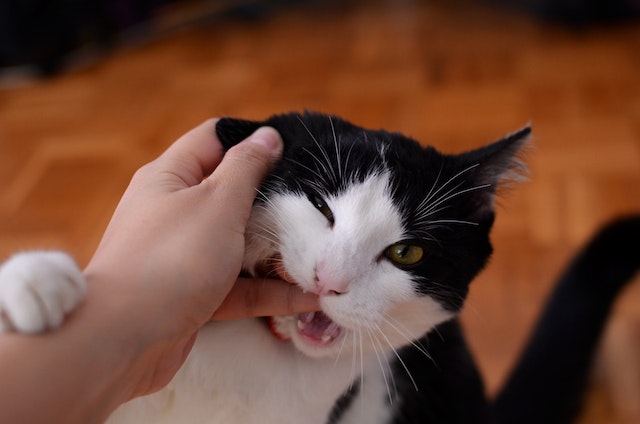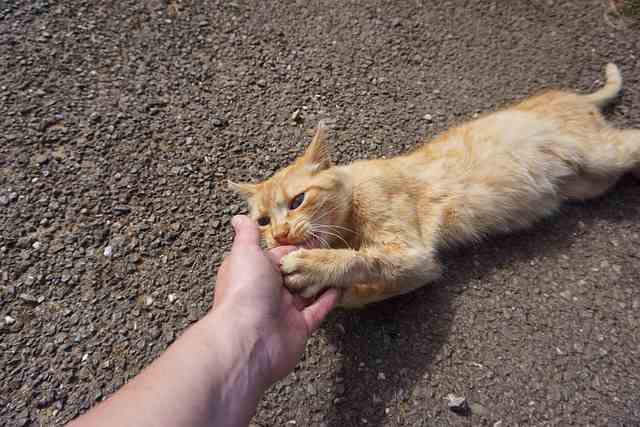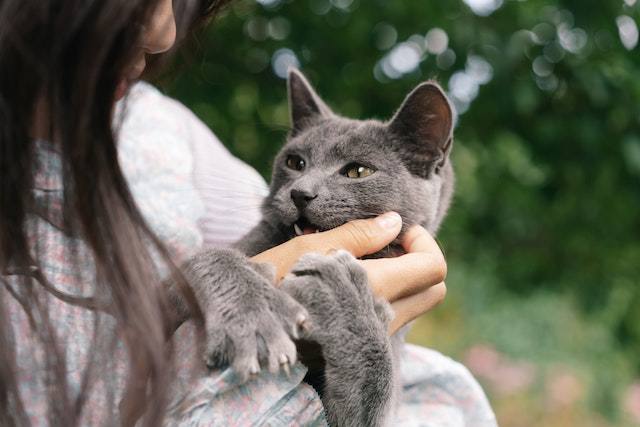Understanding Cats Affectionate Biting

Hey there, fellow feline enthusiasts! Have you ever found yourself on the receiving end of a gentle nip from your beloved cat? Well, fear not, because today we’re diving deep into the mysterious world of cats’ affectionate biting.
From deciphering their seemingly contradictory behavior to understanding the hidden messages behind those tiny nibbles, get ready to unravel the secrets of your cat’s love language like never before!
Cats Affectionate Biting
Cats affectionate biting is a common behavior among our feline friends. It’s their way of showing love and affection towards their owners.
When a cat gently nibbles or bites, it’s often a sign of happiness and contentment.
However, it’s important to distinguish between affectionate biting and aggressive biting, as the latter can be a cause for concern.
If you’re unsure about your cat’s behavior, it’s always a good idea to consult with a veterinarian or a professional animal behaviorist for guidance.
How to Identify Cat Affectionate Biting

Cats often show affection through gentle bites. Look for signs of relaxed body language, such as a softly flicking tail or relaxed ears. Affectionate biting is usually accompanied by purring and kneading.
Pay attention to the intensity of the bite – it should be gentle and not break the skin. Remember, cats have different personalities, so each cat’s affectionate biting may vary.
Differences Between Cat Affectionate And Aggressive Biting
When it comes to cat biting, there are some major differences between affectionate biting and aggressive biting, here are some major differences:
1. Intent: Affectionate biting is usually gentle and playful, and it’s a way for cats to show their love and affection. On the other hand, aggressive biting is done with the intention to harm or defend oneself.
2. Body Language: Cats that engage in affectionate biting often have relaxed body language, with their tail wagging gently and their ears in a neutral position. Aggressive biting, however, is accompanied by tense body language, flattened ears, and a swishing or puffed-up tail.
3. Bite Pressure: Affectionate biting typically involves light pressure, almost like a nibble, without breaking the skin. Aggressive biting, on the other hand, can be forceful and may result in puncture wounds or deep bites.
4. Context: Affectionate biting is often seen during playtime or when cats are seeking attention. It’s usually accompanied by purring and other signs of contentment. Aggressive biting can occur in response to fear, territorial disputes, or feeling threatened.
5. Frequency: Cats that engage in affectionate biting may do so occasionally during play or grooming sessions. Aggressive biting, however, tends to be more frequent and can happen during any interaction that triggers the cat’s aggression.
6. Response to Correction: When a cat is affectionately biting, they usually responds well to gentle redirection or distraction. Aggressive biting, on the other hand, may require more intensive behavior modification techniques and professional guidance to address the underlying issues.
How to Handle Cat Affectionate Biting
When it comes to handling cat affectionate biting, it’s important to remember a few key things. First, recognize that cats may bite as a form of play or communication, so it’s not always aggressive behavior.
Second, provide appropriate outlets for their energy, like interactive toys and playtime. Third, teach them that biting isn’t acceptable by redirecting their attention to toys or treats.
Fourth, avoid punishments or physical restraints, as they can worsen the behavior. And finally, seek advice from a veterinarian or animal behaviorist if the biting persists or becomes aggressive.
Learn more about why cats cry when picked up.
Other Ways Cats Show Affection Aside Gently Bites

Cats have various ways of showing affection aside from gentle biting. Here are some other ways cats may express their affection:
- Purring: Cats often purr when they are content and relaxed. It is a way for them to communicate their happiness and comfort.
- Kneading: When cats knead, they push their paws in and out against a soft surface. This behavior is often associated with feelings of contentment and is reminiscent of the kneading motion kittens make while nursing.
- Head-butting: Cats may rub their head or face against their owners as a sign of affection. This behavior is known as “bunting” and is a way for cats to mark their territory and show trust.
- Grooming: Cats will groom themselves, but they may also groom their owners as a form of social bonding. It is a way for cats to show care and affection.
- Slow blinking: When a cat slowly blinks at you, it is often considered a sign of trust and relaxation. It is like a cat’s way of giving you a “kitty kiss” or a friendly gesture.
- Cuddling: Cats may seek out physical closeness with their owners, such as snuggling up next to them or curling up on their laps. This behavior shows a desire for warmth and companionship.
- Bringing gifts: Some cats may bring their owners small “gifts” like dead prey or toys. While it may not be the most pleasant display of affection, it is a cat’s way of showing their hunting prowess and sharing with their loved ones.
- Rubbing against objects: Cats have scent glands on their face and body, and they will often rub against objects or people to mark them with their scent. This behavior is a way for cats to claim ownership and show affection.
- Following and mimicking: Cats may follow their owners around the house or try to imitate their behavior. This can include sitting or lying in similar positions or copying certain actions. It is a sign of a strong bond and a desire to be near their loved ones.
Remember, each cat is unique, and their ways of showing affection may vary. It’s important to understand and appreciate your cat’s individual preferences and behaviors to strengthen the bond you share.
Learn more about why cats bite.
Related Questions
Why do cats sometimes bite when they’re feeling affectionate?
Cats have a unique way of expressing their love and affection, and sometimes that includes gentle nibbling or biting. It might seem strange to us, but it’s actually a sign of their fondness for you. When a cat bites you softly, it’s their way of showing love and trust. They often do this when they’re feeling content and relaxed.
Is it normal for a cat to bite while being petted?
Yes, it’s not uncommon for cats to give you a gentle nip while you’re petting them. It’s their way of expressing that they’re enjoying the interaction. However, it’s important to pay attention to their body language and stop petting if they become agitated or show signs of discomfort. Some cats have a lower tolerance for petting than others, so it’s crucial to respect their boundaries.
How can I tell the difference between an affectionate bite and an aggressive bite?
It’s essential to understand the distinction between an affectionate bite and an aggressive bite. An affectionate bite is usually gentle, accompanied by purring, kneading, or rubbing against you. The cat’s body language will be relaxed, and they might even close their eyes in contentment. On the other hand, an aggressive bite is forceful and accompanied by hissing, growling, or tensed body language. Aggressive biting is a sign of fear, anger, or discomfort, and it’s important to give the cat space and avoid provoking them further.
Can affectionate biting become a problem behavior?
While affectionate biting is generally harmless, it can become problematic if it becomes too rough or painful. If your cat’s nibbles start to hurt or leave marks, it’s important to address the behavior. You can redirect their biting onto appropriate toys or use positive reinforcement training to discourage the behavior. Seeking advice from a veterinarian or animal behaviorist can also be helpful in managing this behavior.
How can I discourage my cat from biting too hard?
To discourage your cat from biting too hard, it’s important to teach them that gentle play is more rewarding. When your cat bites too hard, immediately stop the play session and withdraw your attention. This will help them understand that biting too hard leads to the end of playtime. Additionally, provide them with appropriate toys and encourage interactive play to redirect their biting instincts onto suitable objects.
Affectionate biting itself is generally not a health concern. However, it’s important to ensure that your cat’s biting behavior doesn’t break the skin or cause any injuries. If you notice any signs of aggression or excessive biting, or if your cat’s biting becomes a compulsive behavior, it’s advisable to consult a veterinarian. They can assess your cat’s overall health and behavior to rule out any underlying medical conditions or behavioral issues that may need to be addressed.
Learn more about things cats like and how to know if your cat likes you.
Conclusion
In conclusion, it’s clear that cats have a unique way of showing affection through biting. While it may seem strange to some, this behavior is a sign of trust and love. So, the next time your furry friend gives you a gentle nibble, remember that it’s their way of saying, “I love you!”
